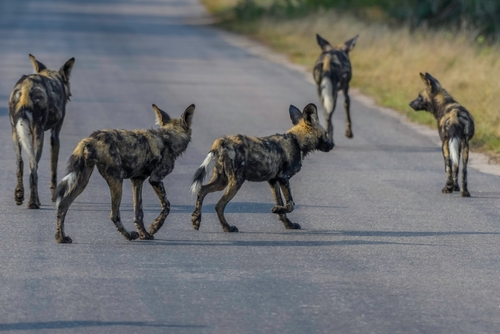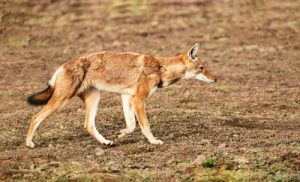
Domestic dogs are some of the best-loved animals on the planet. However, in many cases, their wild canine cousins have not quite been so lucky. For millennia, some canine species have suffered persecution at the hands of man, pushing them into or close to extinction. Here are five of the currently (2023) most endangered species/subspecies of canine on our planet:
Ethiopian Wolf

Photo credit: Giedriius/Shutterstock.com
The Ethiopian wolf (Canis simiensis), also known as the Simien jackal and the Simien fox, is the world’s rarest species of wild dog. Its current numbers are estimated to be somewhere around 450. Woefully, the highly endangered species is also very vulnerable to the threat of rabies. Native to the Ethiopian Highlands, the wolf exists in several subpopulations that are highly remote from each other. Unfortunately, the current situation promotes a high level of inbreeding, increasing the threat of extinction of the species. The rare wolf also faces a continued menace from livestock owners, reduced prey levels, diseases from domesticated dogs and a rapidly growing human population.
Mexican Grey Wolf

Photo credit: Nagel Photography/Shutterstock.com
The Mexican grey wolf (Canis lupus baileyi) is a subspecies of the North American grey wolf. Its range once stretched from the Sonoran and Chihuahuan deserts in Central Mexico to the U.S. states of Texas, New Mexico, and Arizona. Over time, a reduction in its natural prey saw the species turn to prey on livestock. This led to the government-sponsored eradication of the Mexican grey wolf by ranchers. By 1976, the Mexican grey wolf had become an endangered species and remains so to this day. There are currently some 300+ individuals that live in tens of captive-breeding facilities in the U.S. and Mexico. Small groups of the subspecies are periodically released into the wild, in an attempt to build up feral numbers. However, dozens of the released wolves continued to be killed by traffic or hunters.
Red Wolf

Photo credit: Karen crewe/Shutterstock.com
The red wolf (Canis rufus), native to North America, is the rarest of all wolf species. It was once a top-tier predator across much of the midwest and southeast region of the USA. Increasing competition from other predators for dwindling prey and eradication by farmers led to the red wolf’s demise. By 1980, the species was thought to be extinct in the wild, with only ‘tens’ in captivity. Since then, conservation efforts, have saw captive breeding efforts achieve some measure of success. Today, the captive population of the red wolf has increased to some 200 wolves living across several breeding centers. There is also estimated to be a feral wolf population of about 120, living mostly in northeastern North Carolina.
New Guinea Singing Dog

Photo credit: David Havel/Shutterstock.com
The New Guinea singing dog (Canis lupus hallstromi) is one of the world’s oldest and rarest canines. It is thought it once roamed the entire island of New Guinea. However, its habitat is now limited to the mountainous regions of Papua New Guinea. There are currently some 200+ individuals in captive breeding programmes. Last spotted in the 1970s, singing dogs were thought to be now extinct in the wild. That assumption was brought into doubt when a recent genetic study found that the feral Highland wild dog is essentially the same species as the singing dog. However, the size and distribution of wild dog populations are currently unknown. Not all expert opinion concurs as some believe that the singing dog is an ancient relative of the Australian dingo (Canis lupus dingo). Others argue it is simply a subspecies of the domestic dog (Canis familiaris).
Darwin’s Fox

Photo credit: Creative Commons (CC BY-SA 4.0)
Darwin’s Fox (Lycalopex fulvipes) is endemic to Chile. The species is extant in at least two distinct populations. The first can be found in the forests of Chiloé Island while the second lives in the 68 sq. km Nahuelbuta National Park on mainland Chile. However, recent scientific investigation suggests that a number of other isolated populations may also exist in some Chile’s remote mountainous regions. The combined population of the Darwin’s fox is estimated to be heading towards 700 individuals with at least 60% of those living on Chiloé Island. There, the population is seen as relatively safe and stable but others are seen as vulnerable to intrusion from humans, traffic and dogs.
Header photo credit: Shams F Amir/Shutterstock.com





